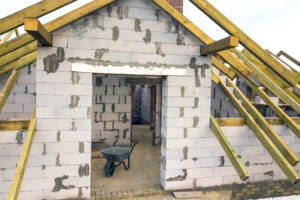When buying a home, ensure you can afford your mortgage on a long-term basis. You’ll save money on interest if you have a shorter loan term, but it might stress you out every month to make your payments. Using the following tools, you can decide which option is best for you.
If you decide how to buy a new home, one of the first decisions you will make will be what kind of loan you will take out. For a tenure of five to thirty years, you can choose between an adjustable-rate and a fixed rate.
It depends on your budget each month, the current interest rates, and your future goals which option is best for you. We can connect you with a lender; Metro Homes can assist you in finding the right loan.
While you wait, here is a primer on a few of the most common mortgage options.
What are the basic mortgage types?
- ARMs (adjustable-rate mortgages)
ARMs are just as they sound – mortgages that have a variable interest rate over the life of the loan. There are usually two numbers to look at when calculating an ARM rate. It indicates the number of years that the interest rate remains the same. Following the fixed period, the second number means how frequently the rate will fluctuate in years.
Five-year fixed-rate mortgages (5/1 ARMs) and Ten-year fixed-rate mortgages (10/1 ARMs) are some of the most popular. The first ten years of a 10-year ARM have a low promotional interest rate – like a 10/1 ARM. For the remaining twenty years, the rate can increase every year.
Even though ARMs often appear to be a sneaky way for lenders to take advantage of unwary borrowers, they often come with a rate cap to prevent drastic and unmanageable interest rate changes. Lifetime rate caps limit the increase in interest over the life of the loan, while periodic rate caps limit the overall growth in interest over the life of the loan.
- Mortgages with fixed rates
Fixed-rate mortgages have a fixed interest rate for the life of the loan; as a result, the payment for principal and interest is the same every month. There are five different types of fixed-rate mortgages, but 30-year mortgages are the most common.
If your credit score is good and interest rates are low, you can take advantage of the advantages of a fixed-rate mortgage. It is possible to refinance a loan if the rates drop later, but this is often expensive when considering additional closing costs on top of the original loan.
Mortgages with a 10-year term
Ten-Year Mortgage: What is it?
Unlike the standard 15- or 30-year mortgage, a 10-year mortgage means your home gets fully paid off in 10 years. You will pay much lower interest in the long run, but you will make higher monthly mortgage payments.
There are primarily two options available for a 10-year loan: a fixed-rate mortgage and a variable-rate mortgage. After ten years, you’ll own your house free and clear because you’ll pay the same amount in principal and interest each month to the bank. There will be no mortgage payments. Whoa… what a concept!
There is also a 10/1 adjustable-rate mortgage, which isn’t technically a 10-year loan. The interest rate on this loan remains the same for the first ten years, even though it lasts for 30 years. However, for the next 20 years, it may change annually. Depending on your personal goals and monthly budget, you will have to decide which is best for you.
Do 10-year fixed mortgages make sense?
Your best option may be a 10-year fixed mortgage if you can secure a low-interest rate, are in a stable employment situation, and earn a salary that provides a good income. By choosing a 10-year mortgage over a 30-year loan with 4% interest, you could save more than $100,000 throughout a $200,000 loan.
As a bonus, shorter-term mortgages usually come with lower interest rates, so you can save even more – if you can afford the high monthly payments. With a 10-year loan, you would have to pay an extra $1,000 in monthly payments.
A mortgage with a 30-year term
30-year mortgages, they sound like.
Looking into 30-year mortgages? Congratulations, you’re a typical Australian. A 30-year mortgage is the standard type – you can pay off your house in 30 years with low monthly payments that are affordable for most people.
Fixed-rate mortgages or adjustable-rate mortgages are obtained for 30 years. Although it is not stated in the name, most ARMs have a term of 30 years. In other words, a 5/1 ARM means your interest rate won’t go up for the first five years, but it will go up every year for the remaining 25 years.
How does a 30-year fixed mortgage benefit you?
Most Australian homeowners can afford 30-year fixed mortgage payments, which is why they are so widely used. Your principal balance is always paid off more quickly, but the lowest possible monthly payment is all you’re responsible for.
Why Do You Need to Choose between 10 and 30 Year Mortgages?
Mortgages with a 10-year term: pros and cons
The repayment period of a 10-year mortgage is one-third that of a 30-year mortgage.
How liberating! If you upgrade your home or reroute your mortgage payment to other things such as paying off school loans or travelling more, it would allow you to upgrade your pad. Additionally, as previously mentioned, you’ll save a lot of money on interest, both since the loan is for a shorter period and since the interest rate is lower.
You may not even be able to obtain a 10-year mortgage if you don’t qualify for it.
An annual payment of $2,000 would be the equivalent of a loan amount of $200,000 at a 4% interest rate. Especially if you’re paying school loans or supporting a family, most Australians can’t afford to set aside that much each month for a whole year.
Mortgages with 30-year terms: pros and cons
Mortgage payments on a 30-year loan are lower, so you can afford to buy rather than rent a home. It is unlikely that you will stay in your home for 30 years anyway since you will sell your house and acquire a new mortgage for your new residence.
You can also use a 30-year loan to pay off your debt that has a higher interest rate, like a student loan, car loan, or credit card loan. These debts have high-interest rates.
One of the worst things about 30-year mortgages is that you’ll have to pay for them for three decades! If you choose a long-term loan instead of a 10-year loan, you will end up paying $100,000 or more in interest.
Need Help Making a Decision?
Ask a local, trusted real estate agent for advice if you plan to purchase a home and aren’t sure whether to choose a 10-year or a 30-year loan. In addition to weighing your options, they can connect you with a great lender who can run some numbers for your unique situation.
Still in greatest despair of understanding home mortgage service in Australia, contact us!







